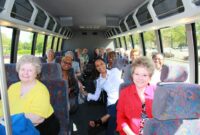Vacations for senior citizens offer a unique opportunity to explore new horizons, relax, and create lasting memories. This guide delves into the planning process, addressing budgeting, accessibility, health considerations, and the cultural enrichment that travel provides for this important demographic. We’ll explore various vacation types, from relaxing cruises to adventurous excursions, ensuring there’s a perfect fit for every senior traveler’s preferences and physical capabilities. Proper planning is key to a successful and enjoyable trip, and this resource aims to provide the tools and information necessary for a seamless and memorable experience.
We will cover practical tips for budgeting, ensuring your trip aligns with your financial resources while still allowing for enjoyable experiences. We’ll also address the crucial aspects of accessibility, ensuring that travel is inclusive and caters to diverse needs and mobility levels. Finally, we will explore the importance of health and wellness during your trip, offering advice on preventative measures and incorporating wellness activities to enhance your overall experience.
Budgeting and Planning Senior Vacations
Planning a memorable and relaxing vacation for senior citizens requires careful budgeting and meticulous planning. This ensures a stress-free experience focused on enjoyment rather than financial anxieties or logistical hurdles. Factors such as travel insurance, potential medical needs, and accessibility requirements must be carefully considered and integrated into the overall budget and itinerary.
Budgeting a Senior Citizen’s Vacation
Creating a realistic budget is crucial for a successful senior vacation. This involves anticipating all potential expenses and allocating funds accordingly. Unexpected costs can significantly impact the overall experience, so thorough planning is key. Consider these key areas when budgeting:
- Travel Costs: This includes airfare, train tickets, or gas expenses for a road trip. Compare prices from different airlines or transportation providers to find the best deals. Consider off-season travel for potential savings.
- Accommodation: Choose lodging that suits the senior’s mobility and needs. Options range from senior-friendly hotels with accessible rooms to vacation rentals with appropriate amenities. Factor in the cost per night and any additional fees.
- Activities and Entertainment: Plan activities that are both enjoyable and feasible given the senior’s physical capabilities. Consider free or low-cost options like parks, museums with accessible entrances, or local events.
- Food and Dining: Budget for meals, snacks, and drinks. Consider the cost of eating out versus preparing some meals in your accommodation. Account for dietary restrictions or preferences.
- Travel Insurance: This is crucial for covering unexpected medical emergencies, trip cancellations, or lost luggage. Comprehensive travel insurance tailored to seniors’ needs is highly recommended.
- Medical Expenses: Include potential costs for prescription medications, over-the-counter remedies, and any anticipated medical appointments or treatments during the trip. Check if your health insurance covers overseas medical expenses.
- Accessibility Needs: Factor in costs associated with mobility aids, such as wheelchair rentals or accessible transportation. Consider the accessibility of chosen destinations and accommodations.
- Miscellaneous Expenses: Allocate funds for souvenirs, tips, and unexpected expenses. It’s always wise to have a buffer for unforeseen circumstances.
Sample 7-Day Vacation Budget
This is a sample budget and may vary depending on destination and individual preferences. Prices are estimates and should be adjusted accordingly.
| Expense Category | Estimated Cost |
|---|---|
| Airfare | $500 |
| Accommodation (7 nights) | $700 |
| Activities & Entertainment | $300 |
| Food & Dining | $400 |
| Travel Insurance | $100 |
| Medical Expenses (Contingency) | $200 |
| Transportation (Local) | $100 |
| Miscellaneous | $100 |
| Total | $2400 |
Planning a Senior-Friendly Vacation: A Step-by-Step Guide
Careful planning is essential for a stress-free and enjoyable senior vacation. The following steps outline a systematic approach:
- Choose a Destination: Select a destination that caters to the senior’s physical capabilities and interests. Consider destinations with good accessibility, manageable climates, and a slower pace of life.
- Research Accommodation: Look for senior-friendly hotels or vacation rentals with accessible features like ramps, elevators, grab bars, and roll-in showers. Read reviews to ensure the accommodation meets the senior’s needs.
- Book Transportation: Arrange transportation that is comfortable and suitable for the senior’s mobility. Consider booking flights or train tickets in advance, especially during peak season.
- Plan Activities: Choose activities that are enjoyable and manageable for the senior. Consider pacing activities throughout the day to avoid fatigue. Incorporate rest periods into the itinerary.
- Pack Appropriately: Pack comfortable clothing, necessary medications, and any mobility aids. Include a first-aid kit with essential supplies.
- Inform Relevant Parties: Inform family members, friends, or medical professionals about the travel plans. Share contact information and itinerary details.
- Review Travel Insurance: Ensure that the travel insurance policy covers medical emergencies, trip cancellations, and other potential issues.
Accessibility and Inclusivity in Senior Travel
Planning a vacation should be an exciting experience, not a source of stress. For senior citizens, ensuring accessibility and inclusivity is paramount to a truly enjoyable and memorable trip. This section explores the importance of accessible travel options and the resources available to make travel easier and more comfortable for seniors with varying mobility levels.
Accessible travel options are crucial for ensuring that senior citizens, regardless of their physical abilities, can participate fully in the joys of travel. The ability to navigate airports, hotels, and attractions with ease significantly impacts the overall experience, transforming a potentially daunting task into a relaxing and fulfilling adventure. Failing to consider accessibility can lead to exclusion and limit the opportunities available to a large and vibrant segment of the population.
Accessible Accommodations
Finding accessible accommodations is often the first step in planning an accessible trip. Many hotels and resorts now offer a range of accessible rooms, featuring features such as roll-in showers, grab bars, wider doorways, and lowered countertops. Websites like Booking.com, Expedia, and TripAdvisor allow users to filter search results by accessibility features, making it easy to find suitable options. Additionally, organizations like the Americans with Disabilities Act (ADA) provide guidelines for accessible accommodations, and many hotels actively promote their ADA compliance. For those with specific needs, contacting the hotel directly to discuss their accessibility features is always recommended.
Accessible Transportation
Accessible transportation is another key element of inclusive senior travel. Many airlines offer assistance to passengers with disabilities, including wheelchair assistance and priority boarding. Train services frequently provide accessible carriages with ramps and designated spaces for wheelchairs. Rental car companies offer vehicles equipped with hand controls or other adaptive devices. Public transportation systems in many cities are also improving their accessibility, with more accessible buses and trains becoming increasingly common. However, it is always advisable to check the accessibility features of specific transportation options in advance to ensure a smooth journey.
Accessible Activities and Attractions
Many popular tourist destinations are actively working to improve their accessibility. Museums and historical sites are often equipped with ramps, elevators, and accessible restrooms. National parks and other outdoor attractions may offer accessible trails and viewing areas. However, accessibility can vary greatly depending on the specific location, so researching beforehand is vital. Websites and brochures often provide details about accessibility features, and contacting the attraction directly can clarify any uncertainties. Consider choosing activities that are appropriate for your physical capabilities and avoid overexertion.
Comparing and Contrasting Travel Options
Different travel options cater to different accessibility needs. For example, a guided tour may provide more support and assistance than independent travel. Cruises often offer accessible cabins and amenities, but may involve more walking than other modes of transportation. All-inclusive resorts can offer convenience and accessibility, while independent travel allows for greater flexibility but requires more careful planning regarding accessibility. The best travel option depends on the individual’s specific needs and preferences. A thorough assessment of personal mobility and the accessibility features of potential destinations is crucial for selecting the most suitable option.
Social and Cultural Aspects of Senior Travel
Travel offers significant social and emotional benefits for senior citizens, extending beyond mere relaxation. It provides opportunities for personal growth, enriching social connections, and a renewed sense of purpose, combating feelings of isolation and loneliness often associated with aging. The exploration of new cultures and environments stimulates the mind, fostering cognitive well-being and promoting a sense of adventure.
Exploring new cultures and interacting with diverse populations can significantly enhance the social and emotional well-being of senior travelers. The stimulation provided by unfamiliar environments and the opportunity to engage in new experiences can combat feelings of isolation and promote a sense of purpose. Furthermore, travel allows for the creation of new social connections and the strengthening of existing ones, fostering a sense of community and belonging.
Destinations Offering Enriching Cultural Experiences
Many destinations cater specifically to the interests and needs of senior travelers, offering enriching cultural experiences alongside comfortable accommodations and accessible activities. These locations prioritize ease of navigation, thoughtful pacing, and opportunities for meaningful engagement with local culture. For example, the charming towns of Tuscany, Italy, offer a slower pace of life, allowing for leisurely exploration of art, history, and culinary traditions. The vibrant streets of Seville, Spain, provide a feast for the senses, with flamenco shows, historical architecture, and delicious tapas readily available. Similarly, the serene beauty of Kyoto, Japan, offers a unique blend of traditional culture and modern amenities, perfect for a contemplative and enriching travel experience. These locations are chosen for their blend of accessibility, cultural richness, and opportunities for relaxation.
Creating a Balanced Itinerary
A well-planned itinerary is crucial for maximizing the benefits of senior travel. It should carefully balance relaxation and cultural engagement to avoid overwhelming the traveler. A sample itinerary might include a morning spent exploring a historical site, followed by a leisurely lunch at a local restaurant, and an afternoon dedicated to relaxation by the pool or at a spa. Evenings could involve attending a cultural performance or enjoying a quiet dinner with a view. This balanced approach ensures that the trip is both stimulating and restful, allowing seniors to fully appreciate the cultural experiences while also prioritizing their well-being. Flexibility is key; unexpected delays or changes in energy levels should be accommodated without compromising the overall enjoyment of the trip. This allows for a personalized experience tailored to the individual’s preferences and capabilities.
Last Word
Planning a vacation as a senior citizen should be an exciting and fulfilling process. By carefully considering your budget, accessibility needs, health, and desired level of activity, you can craft a memorable journey. Remember that travel is a fantastic opportunity for personal growth, cultural exploration, and creating lasting memories. This guide has aimed to equip you with the knowledge and resources necessary to plan a perfect trip that prioritizes your comfort, well-being, and enjoyment. Embrace the adventure, and enjoy the journey!




